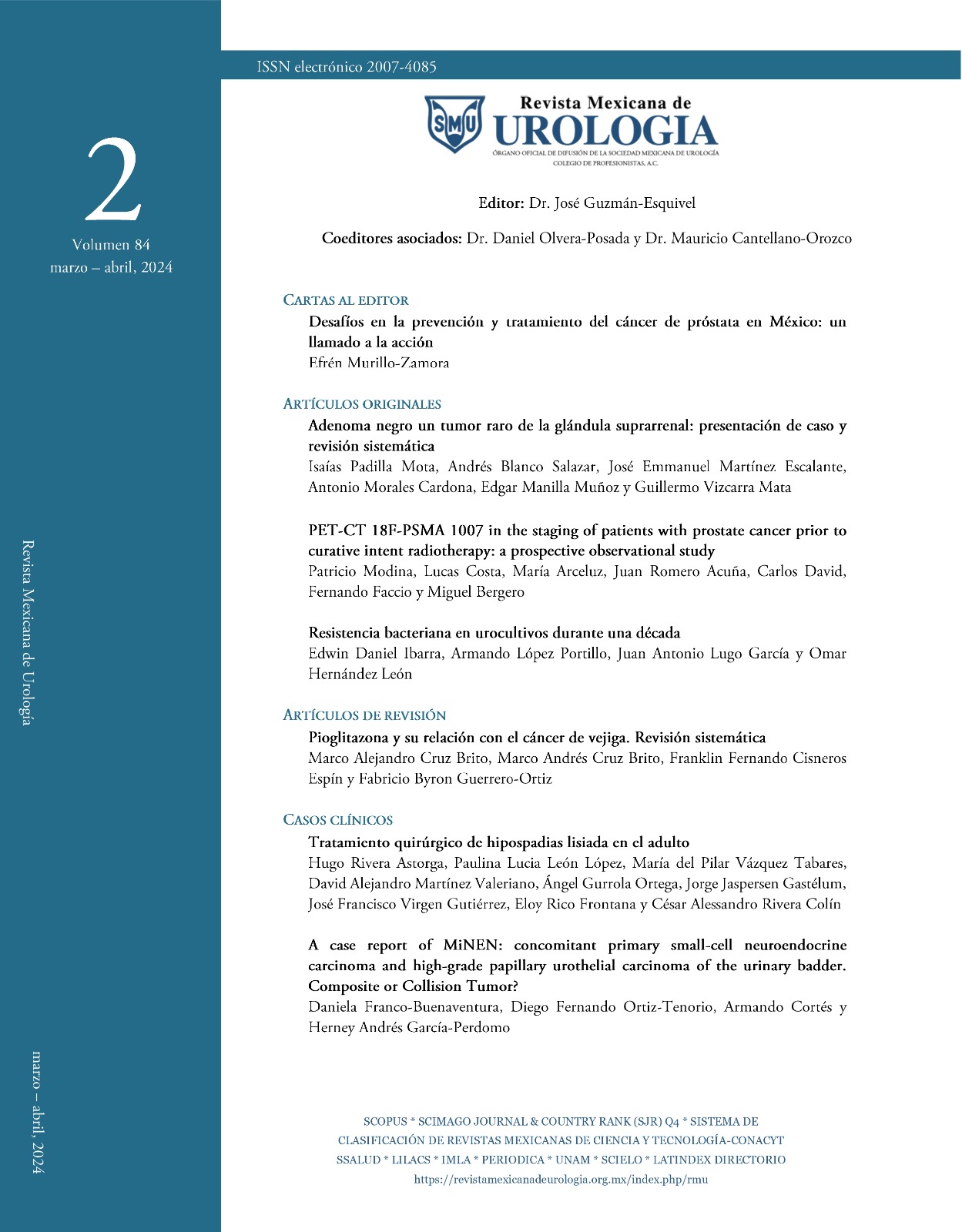Bacterial resistance in urine cultures during a decade
DOI:
https://doi.org/10.48193/s2nr5761Keywords:
Urine, Urological diseases, Urinary tract, Antibiotic resistance, Bacteria, Bacterial diseasesAbstract
Introduction: Bacterial resistance to antibiotics is a global problem; Due to its great variability, each hospital should carry out its own microbiological surveillance.
Objective: To identify changes in bacterial resistance in urine cultures with Gram-negative isolation from the urology department over a decade.
Material and methods: Analytical, retrospective cross-sectional study, 1072 urine cultures requested by the urology department of Hospital Juárez de México were collected between 6/01/2012 and 5/31/2022. The percentage of resistance by germ and antibiotic was divided into three periods: initial, intermediate and final to compare with X2 trends. According to the sensitivity report, high resistance >16 and high sensitivity ≤2 were defined.
Statistical analysis was performed using IBM SPSS V.25 software and Epi Info Companion V.5.5.10 software.
Results: For a decade, the urology service of Hospital Juárez de México has a total of 1072 records in the database, initial date 6/01/2012 and end date 06/01/2022. The most frequent germs were Escherichia coli 709 (66 %), Klebsiella pneumoniae 61 (6 %) and Pseudomonas aeruginosa 56 (5 %). The majority of antibiotics showed persistence in the percentage of resistance. Amoxicillin with clavulanate had a significant decrease (X2 Tend=13.17, p=0.0003). Cefepime (X2 Tend=4.84, p=0.027) and amikacin (X2 Tend=5.76, p=0.016) had a slight significant increase. Cefazolin (X2 Tend=5.00, p=0.025), Levofloxacin (X2 Tend=7.81, p=0.005), Ceftazidime (X2 Tend=3.74, p=0.05) significantly increased the percentage of resistance.
Conclusion: Dividing the patterns of bacterial resistance by uropathogens, family of antibiotics, levels of resistance and sensitivity, improves knowledge and favors a better selection of treatments in the population attended by the urology service of the Hospital Juárez de México.
References
Stamm WE, Norrby SR. Urinary Tract Infections: Disease Panorama and Challenges. The Journal of Infectious Diseases. 2001;183(Supplement_1): S1–S4. https://doi.org/10.1086/318850.
Foxman B. The epidemiology of urinary tract infection. Nature Reviews Urology. 2010;7(12): 653–660. https://doi.org/10.1038/nrurol.2010.190.
Laupland KB, Ross T, Pitout JDD, Church DL, Gregson DB. Community-onset Urinary Tract Infections: A Population-based Assessment. Infection. 2007;35(3): 150. https://doi.org/10.1007/s15010-007-6180-2.
Zowawi HM, Harris PNA, Roberts MJ, Tambyah PA, Schembri MA, Pezzani MD, et al. The emerging threat of multidrug-resistant Gram-negative bacteria in urology. Nature Reviews. Urology. 2015;12(10): 570–584. https://doi.org/10.1038/nrurol.2015.199.
Tandogdu Z, Cek M, Wagenlehner F, Naber K, Tenke P, van Ostrum E, et al. Resistance patterns of nosocomial urinary tract infections in urology departments: 8-year results of the global prevalence of infections in urology study. World Journal of Urology. 2014;32(3): 791–801. https://doi.org/10.1007/s00345-013-1154-8.
Papanicolaou N, Pfister RC. Acute renal infections. Radiologic Clinics of North America. 1996;34(5): 965–995.
Wagenlehner F, Tandogdu Z, Bartoletti R, Cai T, Cek M, Kulchavenya E, et al. The Global Prevalence of Infections in Urology (GPUI) Study: A Worldwide Surveillance Study in Urology Patients. European Urology Focus. 2016;2(4): 345–347. https://doi.org/10.1016/j.euf.2016.03.004.
Wagenlehner FME, Bjerklund Johansen TE, Cai T, Koves B, Kranz J, Pilatz A, et al. Epidemiology, definition and treatment of complicated urinary tract infections. Nature Reviews Urology. 2020;17(10): 586–600. https://doi.org/10.1038/s41585-020-0362-4.
Magiorakos AP, Srinivasan A, Carey RB, Carmeli Y, Falagas ME, Giske CG, et al. Multidrug-resistant, extensively drug-resistant and pandrug-resistant bacteria: an international expert proposal for interim standard definitions for acquired resistance. Clinical Microbiology and Infection. 2012;18(3): 268–281. https://doi.org/10.1111/j.1469-0691.2011.03570.x.
Cornejo-Juárez - P, Velásquez-Acosta - C, Sandoval - S, Gordillo - P. Patrones de resistencia bacteriana en urocultivos en un hospital oncológico. Salud Pública de México. 2007;49(5): 330–336.
Garza-Montúfar ME, Treviño-Valdez PD, Garza-Salinas LHD la. Resistencia bacteriana y comorbilidades presentes en pacientes urológicos ambulatorios con urocultivos positivos. Revista Médica del Instituto Mexicano del Seguro Social. 2018;56(4): 347–353.
Guajardo-Lara CE, González-Martínez PM, Ayala-Gaytán JJ. Resistencia antimicrobiana en la infección urinaria por Escherichia coli adquiridaen la comunidad. ¿Cuál antibiótico voy a usar? Salud Pública de México. 2009;51(2): 157–159.
Chávez Valencia V, Gallegos-Nava S, Arce Salinas CA. Patrones de resistencia antimicrobiana y etiología en infecciones urinarias no complicadas. Gaceta médica de México. 2010;146(4): 269–273.
Rendón Medina, M A, Reyes Arcos A, Rosas Bello J B, Rodríguez Weber F. Infecciones de vías urinarias. Patrón de resistencia in vitro de E. coli y E. coli ESBL a quinolonas, trimetoprima-sulfametoxazol y nitrofurantoína. Medicina Interna de México. 2012;28(5): 434–439.
Downloads
Published
Issue
Section
License
Copyright (c) 2024 Revista Mexicana de Urología

This work is licensed under a Creative Commons Attribution-NonCommercial-NoDerivatives 4.0 International License.






